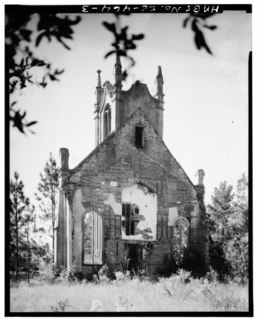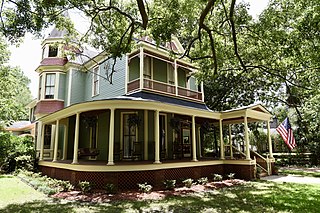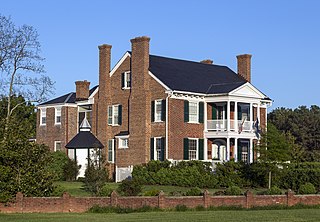
This is a list of sites in Minnesota which are included in the National Register of Historic Places. There are more than 1,700 properties and historic districts listed on the NRHP; each of Minnesota's 87 counties has at least 2 listings. Twenty-two sites are also National Historic Landmarks.

The Charles Young Buffalo Soldiers National Monument, a National Monument of the United States, commemorates the life of Charles Young (1864-1922), an escaped slave who rose to become a Buffalo Soldier in the United States Army and its first African-American colonel. It is located on United States Route 42 in Wilberforce, Ohio, in a house purchased by Young in 1907 that was designated a National Historic Landmark in 1974. The monument is administered by the National Park Service; the house is open by appointment for tours.

The Moran Bay Patrol Cabin was built by the Civilian Conservation Corps about 1932. The log structure was located in the northern backcountry of Grand Teton National Park, and was built to a standard design for such structures, in the National Park Service Rustic style, but for the U.S. Forest Service, which administered much of the area prior to the expansion of the park in 1943. The Upper Granite Canyon Patrol Cabin is similar.

Plantersville is an unincorporated community in Georgetown County, South Carolina, United States. The community is six miles north of Georgetown on U.S. Route 701. Plantersville is home to many plantations and rice fields. Plantersville Elementary School is also located within the community.

The Joseph Campau House is a private residence located at 2910 East Jefferson Avenue in Detroit, Michigan. It was listed on the National Register of Historic Places in 1985. The house is currently used as a law office.

The Franklin H. Walker House was a private residence located at 2730 East Jefferson Avenue in Detroit, Michigan. It was also known as Doctor's Hospital. The house was listed on the National Register of Historic Places in 1985, but subsequently demolished. It was at the time the largest remaining house along Jefferson Avenue.

Paradise Park Historic District is located in Thomasville, Georgia. It was listed on the National Register of Historic Places 1984 with an increase in 2002. It consists of Thomasville's Paradise Park, and properties including 15 contributing buildings and one non-contributing building.

This is a list of the National Register of Historic Places listings in Koochiching County, Minnesota. It is intended to be a complete list of the properties and districts on the National Register of Historic Places in Koochiching County, Minnesota, United States. The locations of National Register properties and districts for which the latitude and longitude coordinates are included below, may be seen in an online map.

There are 70 properties listed on the National Register of Historic Places in Albany, New York, United States. Six are additionally designated as National Historic Landmarks (NHLs), the most of any city in the state after New York City. Another 14 are historic districts, for which 20 of the listings are also contributing properties. Two properties, both buildings, that had been listed in the past but have since been demolished have been delisted; one building that is also no longer extant remains listed.

Prince Frederick's Chapel Ruins is a historic site in Plantersville, South Carolina.

Summer Chapel Rectory, Prince Frederick's Episcopal Church is a historic rectory associated with Prince Frederick's Episcopal Church on CR 52 near Plantersville, Georgetown County, South Carolina. It was built about 1850, and is a 1 1/2-story, "U"-shaped frame building with a clapboard exterior on a raised brick foundation. It has a standing seam metal gable roof and a one-story engaged porch extends across the façade. The rectory was moved to its present location in 1877 after the original chapel was abandoned and served as the rectory for Summer Chapel, Prince Frederick's Episcopal Church.

Summer Chapel, Prince Frederick's Episcopal Church is a historic Episcopal chapel associated with Prince Frederick's Episcopal Church and located on CR 52 in Plantersville, Georgetown County, South Carolina. It was finished by 1836, and is a one-story, frame chapel with clapboard exterior walls and standing seam metal gable roof. The entrance is sheltered by a hipped roof porch. In 1877 it was moved to Plantersville, to replace the summer chapel there, along with the Summer Chapel Rectory, Prince Frederick's Episcopal Church.

The C. Bascom Slemp Federal Building, also known as the Big Stone Gap Post Office and U.S. Post Office and Courthouse, is a historic courthouse and post office building located in Big Stone Gap, Wise County, Virginia. It was designed by the Office of the Supervising Architect under James Knox Taylor and built between 1911 and 1913. It is a three-story, seven bay, stone building with a low hipped roof in the Second Renaissance Revival style. The front facade features a three bay Tuscan order portico consisting of four pairs of coupled, unfluted columns. The building is named for Congressman C. Bascom Slemp.

Cuckoo is a Federal style house in the small community of Cuckoo, Virginia near Mineral, Virginia, built in 1819 for Henry Pendleton. Cuckoo was listed on the National Register of Historic Places on August 19, 1994. The house is prominently sited on U.S. Route 33, which curves around the house. Cuckoo's interior retains Federal detailing alongside Colonial Revival elements from the early 20th century. The house is notable for its design, prominence and its association with the Pendleton family of doctors. The house was named for the Cuckoo Tavern, which stood nearby from 1788. It has been in the Pendleton family since its construction.

Christian Church and Parsonage is a historic church and parsonage in Plantersville, Alabama. Both the church and the parsonage were built in 1898. The pair were added to the National Register of Historic Places in 1987.

The Antique Store is a historic commercial building in Plantersville, Dallas County, Alabama. It is the oldest surviving commercial building in the community. The one-story, wood-frame structure was built in 1870. The main facade is three bays wide, with a pedimented one-story porch spanning the entire width. A side ell, added after the initial construction, projects from the south side of the main block. It was added to the National Register of Historic Places on January 29, 1987, as a part of the Plantersville Multiple Resource Area.

The Driskell–Martin House is a historic house in Plantersville, Dallas County, Alabama. It is the oldest surviving high style residence in the community. The two-story wood-frame house was built for Thomas Sanford Driskell, a planter and a merchant from Virginia, in 1850. The builders were Nelson Mitchell and Massena Godwin. The house was used as a Union headquarters during the American Civil War. Their forces occupied it during Wilson's Raid through Alabama in April 1865. The house remained in the Driskell family until purchased by Dr. Thomas Munroe Martin in 1915.

The Todd House, also known as the Todd-Biscoe House, is a historic house in Plantersville, Dallas County, Alabama. The 1+1⁄2-story Carpenter Gothic cottage was built from 1867–68 for Dr. Samuel G. Todd, the first dentist in Plantersville. Carpenter Gothic houses are relatively rare in Alabama. Architectural historians consider this example to be a good representation of the house designs advocated by Richard Upjohn and Alexander Jackson Davis.

Merritt-Winstead House is a historic home located near Roxboro, Person County, North Carolina. It was built in 1915, as a 1 1/2-story, transitional Queen Anne / Colonial Revival style frame dwelling. It was enlarged in 1934 to a two-story, three bay, Colonial Revival dwelling veneered in brick with a one-story, wrap-around American Craftsman-style front porch. A one-story vestibule was added to the front facade about 1950. Also on the property are a contributing carport, garage, tennis court, swimming pool complex, well house, two grape arbors, Bill Joe's Play Doctor's Office, retaining walls, storage building, barbeque grill, and rock walls and a boxwood garden.

Dunham's Mill, also known as Parry's Mill, is a historic building located at 7 Lower Center Street in Clinton, New Jersey, United States. The gristmill was in operation from 1837 to 1952. It was added to the National Register of Historic Places on April 15, 1982, for its significance in commerce and industry. In 1995, it was also listed as a contributing property of the Clinton Historic District. It shares the Clinton Dam across the South Branch Raritan River with the David McKinney Mill on the other side of the river. Since 1952, it has been home to the Hunterdon Art Museum, described by an art critic as the "most charming and picturesque" museum in the state.





















